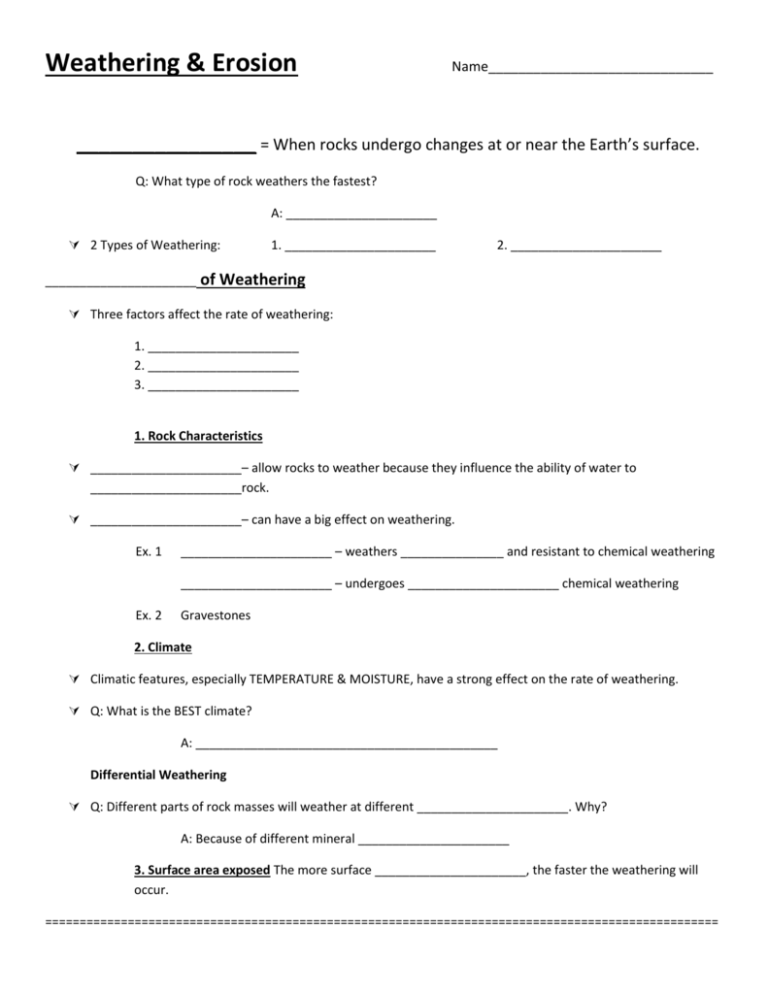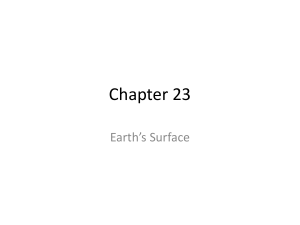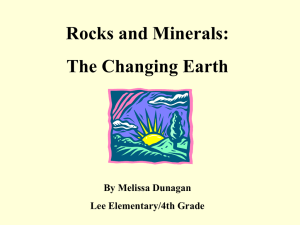ES 11 Weathering and Erosion Unit 6 Part 2
advertisement

Weathering & Erosion Name______________________________ ________________ = When rocks undergo changes at or near the Earth’s surface. Q: What type of rock weathers the fastest? A: ______________________ 2 Types of Weathering: 1. ______________________ 2. ______________________ ______________________ of Weathering Three factors affect the rate of weathering: 1. ______________________ 2. ______________________ 3. ______________________ 1. Rock Characteristics ______________________– allow rocks to weather because they influence the ability of water to ______________________rock. ______________________– can have a big effect on weathering. Ex. 1 ______________________ – weathers _______________ and resistant to chemical weathering ______________________ – undergoes ______________________ chemical weathering Ex. 2 Gravestones 2. Climate Climatic features, especially TEMPERATURE & MOISTURE, have a strong effect on the rate of weathering. Q: What is the BEST climate? A: ____________________________________________ Differential Weathering Q: Different parts of rock masses will weather at different ______________________. Why? A: Because of different mineral ______________________ 3. Surface area exposed The more surface ______________________, the faster the weathering will occur. ================================================================================================== Physical Weathering ______________________= A type of weathering in which no new substance is formed. Rock is only ______________________physically into smaller pieces of rocks. a) Occurs mostly in temperate zones where you have ______________________ freezing and ______________________. b) Occurs when ______________________ take root in cracks and break rock up. c) Occurs when animals ______________________ rocks and break them down Types of Physical Weathering 1. Joints Joints = Mass of rock is pushed upward at the surface reducing the pressure on the rock layer. Result: slabs of rock break free and gravity pulls them down slope. (Talus) a. occurs when granite expands into long curved cracks parallel to the surface. b. When joints develop on the surface of the rock, the rock breaks into curved sheets that peel away from the underlying rock in a process called ______________________. c. ____________________________________________= repeated daily heating and cooling of rock; d. heat causes ______________________; cooling causes ______________________. e. different minerals expand and contract at different rates b) causes ______________________ along mineral boundaries. 2. ______________________ = where water ______________________into cracks or joints and ______________________. a) When water freezes it expands by ________. This process widens cracks in the rock. b) Over time the fracture will expand as the freeze/thaw cycle continues. Can result in the formation of a ______________________ (loose rock). ______________________= the freefall of rock from a cliff. Rock falls are often the result of physical weathering such as ice wedging. The rock typically accumulates at the ______________________ of the cliff in the form of talus. Rock falls are often triggered by ______________________. 3. ______________________ ______________________= when a plant, especially trees, sink ______________________into existing rock joints and fractures. As the root grows it forces the fracture to ______________________. Sometimes this cracks ______________________ into smaller pieces. ______________________that burrow in the ground expose rocks and cause them to be weathered. 4. ______________________ =Moving material ______________________ (abrading) a surface. The surface can fracture, flake, or break off small particles. Rounded rocks have been exposed to more mechanical weathering; so they have: a) traveled ______________________, b) ______________________for longer, or c) existed in areas with more rubbing and ______________________ ---------------------------------------------------------------------------------------------------------------------------------------------------------------- Chemical Weathering ______________________Occurs mostly in warm climates a) Typically ______________________ strong minerals with ______________________ minerals b) 3 common chemical reactions associated with chemical weathering are ______________________ ______________________ ______________________ Types of Chemical Weathering 1. ______________________ = when rocks and/or minerals are dissolved by ______________________. The dissolved material is transported away leaving a space in the rock. water (rain) + ______________________ (from air) H2O + CO2 ______________________ (reacts with rocks) H2CO3 ______________________ (from pollution or natural) dissolve limestone allowing for additional water to gain entrance. Results of Dissolution ______________________ Systems Caves form when dissolution occurs along a series of fractures in limestone to create a larger opening. Water passing through the rock enlarges the cave and associated re-precipitation can form a variety of features. The dissolved limestone is transported through the cave and may be precipitated to form new features such as stalagtites that grow downward from the cave ceiling and stalagmites that grow up from the floor. If they meet they form a compound cave formation such as a column. ______________________ Not all the products of dissolution are below ground. Sinkholes form at the surface from the collapse of the roof of an underlying cavern or by dissolution of rock along a series of fracture surfaces. 2. ______________________ Weathering = When water enters along cracks or joints in a rock, and weathers the __________ and _____________ very fast. Why? because they have a greater ______________________ eg., when minerals in rocks turn to clay. a) The rectangular blocks outlined by joints are attacked by chemical weathering processes, (b) but the ______________________ and edges are weathered most ______________________. (c) When a block has been weathered so that it is ______________________, its entire surface is weathered evenly, and _____further change in shape occurs. often the weathered rock peels off the unweathered core like onion skin. 3. ______________________ (Granite Weathering) = when minerals react with ______________________ to form other products. eg., Feldspar, the most common mineral in rocks on the earth's surface, reacts with water to form a secondary mineral such as kaolinite (a type of clay) and additional ions that are dissolved in water. Then the weaker clay is readily worn away by physical weathering. ______________________ Leaching is the process where minerals that are soluble and dissolved are carried down ______________________ the soil by the movement of ______________________. 4. ______________________Precipitation = wet forms of acid pollution that can be found in rain, sleet, snow, fog, and cloud vapor. Precipitation is considered to be acidic when its pH falls below ____ (which is 25 times more acidic than pure distilled water). How do we measure pH? Nitrogen oxides (NOx) and sulfur dioxide form ACID PRECIPITATION Acid deposition has a variety of effects including damage to: -______________________, -______________________, -______________________, and -human ______________________. Acid rain also reduces how far and how clearly we can see through the air, an effect called ______________________. Acid rain is measured using a scale called "pH." The lower a substance's pH, the more acidic it is. Pure water has a pH of 7.0. Normal rain is slightly acidic because carbon dioxide dissolves into it, so it has a pH of about 5.5. As of the year 2000, the most acidic rain falling in the US has a pH of about 4.3. 5. ______________________ ______________________ and ______________________grow on rocks and produce weak acids that dissolve the surface of rocks. Example: Humic Acid 6. ______________________ Oxygen, the second most common element in the air we breathe, reacts with iron in minerals to form ______________________minerals, e.g. hematite (rust). As many minerals contain iron, it is not unusual to see _____colored rocks like the example from Arches National Park. ================================================================================================== Erosion Erosion = A process by which weathered products are picked up and carried away and re-deposited in a different area. Agents of Erosion: 1. ______________________ 2. ______________________ 3. ______________________ 4. ______________________ 5. ______________________ 1. ______________________ A. Wave Energy a) waves crash into rocks over long periods of time + the rocks are broken down into smaller and smaller pieces until they become __________________. b) Waves usually play a major role in ______________________and ______________________the shoreline. ______________________= the boundary between land and a body of water. c) As the wind moves across the ocean surface, it produces ripples called ______________________. The size of a wave depends on a) how hard the wind is blowing, b) the distance over which it blows (fetch) c) how long the wind blows. B. ______________________= a grouping of waves. When wave trains reach shallow water, a) the _________________ of the wave drags against the sea floor, _________________ the wave down. b) the _________________ part of the wave moves ______________________and grows taller, and begins to curl and break. These breaking waves are known as ______________________. a. Tremendous energy is released when waves break. b. Crashing waves can ______________________ solid rock and throw broken rocks back against the shore. c. Breaking waves also ______________________fine grains of sand, which are picked up by the waves and wear down and ______________________ coastal rock. Shaping a Shoreline ______________________are formed when waves erode and undercut rock to produce steep slopes. C. Wave Deposits ______________________ = areas of the shoreline made up of material deposited by waves. Wave Angle and Sand Movement a. Waves moving at an angle to the shoreline push water along the shore and create ______________________ b. Longshore currents move sand in a ______________________ pattern along the beach. Offshore Deposits When waves erode material from the shoreline, longshore currents can transport and deposit the material offshore, which creates landforms in open water. a. A ____________________ is an underwater or exposed ridge of sand, gravel, or shell material. b. A barrier ______________is an exposed sandbar connected to the shoreline. 2. ______________________is the major cause of erosion Runoff and Erosion a. Rain can: Evaporate, Soak into soil or ______________________ b. Amount of runoff affected by: i. Amount of ______________________ ii. ______________________ population iii______________________of the land iv. Soil ______________________ c. _____________ – _____________- _____________- _____________- Rivers d. _____________: Sediment/debris carried by the stream i. Tumbled across the stream bottom ii. Carried in the water column iii. Dissolved f. Deposits by the River i. Erodes _____________ of curve ii. Deposits on _____________ of curve iii.. _____________: River leaves valley and dumps into the ocean vi. Flood Plains and Levees 1. _____________: _____________ like deposits of large particles 2. _____________: very fertile soil from flooded water Drainage _____________: network of the actual _____________, tributaries and rivers Drainage _____________: the _____________ drained by the drainage System 3. _____________ The Process of Wind Erosion and Deposition _____________ is the skipping and bouncing movement of sand or other sediments, caused by _____________. Moving sand grains knock into one another, bounce up into the air, fall forward, and strike other sand grains, causing them to roll and bounce forward. _____________ is a form of wind erosion in which fine, dry soil particles are blown away, _____________ the top layer of fine sediment or soil and leaving behind rock fragments that are too heavy to be lifted by the wind. may cause ________________________, which is a surface consisting of pebbles and small broken rock. __________________________= Scooped-out depressions in the landscape. _____________ is the grinding and wearing away of rock surfaces through the mechanical action of other rock or sand particles. Abrasion commonly happens in areas where there are strong winds, loose sand, and soft rocks. The blowing of millions of sharp sand grains creates a _____________ effect, helping erode, smooth, and _____________rocks. _____________ is a deposit of windblown, _____________ sediment. Because wind can carry fine-grained material much higher and farther than it carries sand, loess deposits are sometimes found _____________ from their source. _____________ = mounds of wind-deposited sand. When the wind hits an obstacle, the wind slows down, depositing the heavier material. The material collects, creating an additional obstacle and eventually forming a mound that _____________ the original obstacle. A dune keep its shape, even though it moves. 3. Ice/Glaciers Erosion and Deposition by Ice _________________ = a large mass of moving ice. o o o They are capable of eroding, moving, and depositing large amounts of rock materials. Glaciers form in areas so cold that _________________stays on the ground ________________. Because glaciers are so massive, the pull of _________________ causes them to flow slowly, like “rivers of ice.” a) _________________Glaciers = formed in mountainous areas. One common type of alpine glacier is a _________________ glacier. Valley glaciers form in valleys originally created by _________________. As these glaciers slowly flow downhill, they widen and straighten the valleys into broad _________________. b) _________________Glaciers = huge, continuous masses of ice that can spread across entire continents. o o o The largest continental glacier in the world covers almost all of _________________. This ice sheet is approximately one and a half times the size of the United States Is more than 4,000 m thick in some places. Glaciers on the Move. When enough ice builds up on a slope, the ice begins to _________________. o o c) ___________ glaciers move _______________ than thin glaciers the _________________the slope, the _________________the glaciers will move. Glaciers move in two ways: sliding and flowing. _________________ = when its weight causes the ice at the bottom to melt. _________________ = ice crystals within the glacier slip over each other. d) Glacier movement is affected by _________________. As the Earth cools, glaciers grow. About 10,000 years ago, a continental glacier covered most of North America. Landforms Carved by Glaciers As the glaciers expanded, due to their accumulating weight of snow and ice, they crush and abrade surface rocks and bedrock. The resulting erosional landforms include: _________________: Bowl shaped rock feature found at the head of a glacier _________________: an angular, sharply-pointed mountain _________________ which results from erosion due to multiple glaciers diverging from a central point. __________________________________: created by mountain glaciers. When filled with ocean water so as to create an inlet, these water-filled valleys are called _________________. _________________: spiky high land between two glaciers. Types of Glacial Deposits Glacial drift is the general term used to describe all material carried and deposited by glaciers. o is divided into two main types, _________________and _________________. o _________________= Unsorted rock material that is deposited directly by the ice when it _________________. (Unsorted means that the till is made up of rock material of different sizes.) o _________________. =deposit that forms ridges along the _________________of glaciers. o _________________is a glacial deposit that has been sorted and layered by the action of streams or meltwater. o Streams carry sorted material and deposit it in front of the glacier in a broad area called an __________________________________. 4. _________________ The Effect of Gravity on Erosion and Deposition Gravity is an agent of erosion and deposition. It influences the movement of water and ice, and it causes rocks and soil to __________________________________. __________________________________= the steepest angle at which loose material ___________ downslope. Material such as rock, soil, or snow moves downhill until the slope becomes stable. o o The angle of repose is different for different surface material. __________________________________ level determine at what angle material will move down-slope. _____________________________________________________________________________________ ________________________________ = the movement of any material, such as rock, soil, or snow, downslope. a) _________________= when loose rocks fall down a steep slope. The rocks can range in size from small fragments to large boulders. b) _________________ = sudden and rapid movements of a large amount of material downslope. c) _________________ = when a _______ of land becomes detached and slides downhill. o The _________________type of landslide. d) _________________ = are rapid movements of large masses of mud. e) _________________ are mudflows caused by _________________or heavy rains on volcanic ash. o o f) Lahars can travel at speeds greater than 80 km/h and can be ____________________________. On volcanoes with snowy peaks, an eruption can suddenly melt a great amount of ice. Water from the ice liquefies the soil and volcanic ash to produce a hot mudflow that rushes downslope. _________________ = the _____________ mass movement of material downslope. o rapid mass movements are visible and dramatic, BUT slow mass movements occur _________________ and more _________________is moved collectively.









